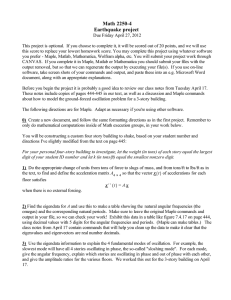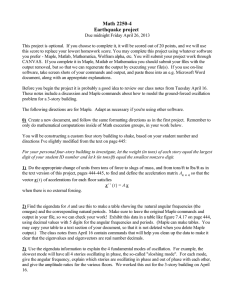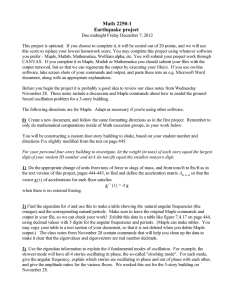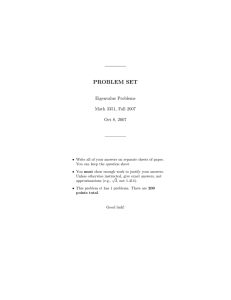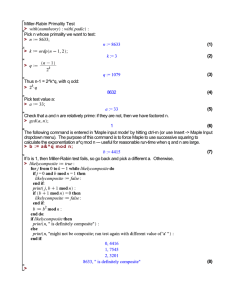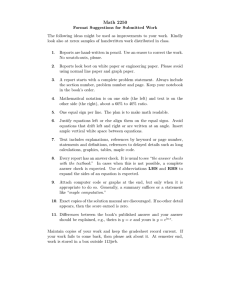Math 2250 Earthquake project
advertisement
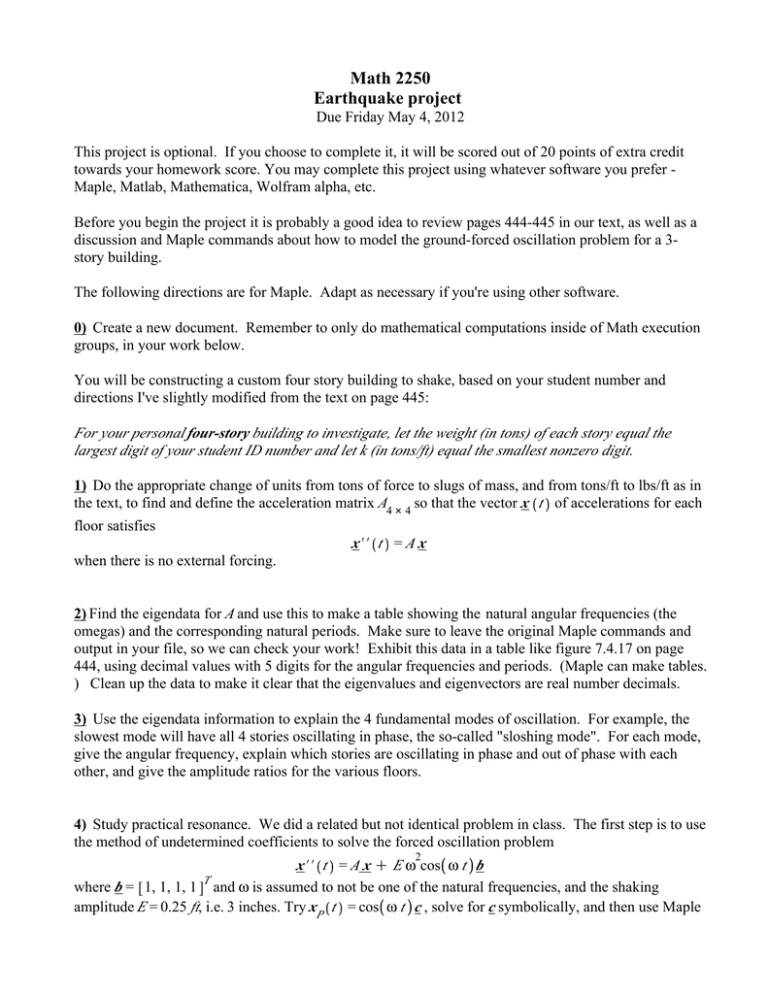
Math 2250 Earthquake project Due Friday May 4, 2012 This project is optional. If you choose to complete it, it will be scored out of 20 points of extra credit towards your homework score. You may complete this project using whatever software you prefer Maple, Matlab, Mathematica, Wolfram alpha, etc. Before you begin the project it is probably a good idea to review pages 444-445 in our text, as well as a discussion and Maple commands about how to model the ground-forced oscillation problem for a 3story building. The following directions are for Maple. Adapt as necessary if you're using other software. 0) Create a new document. Remember to only do mathematical computations inside of Math execution groups, in your work below. You will be constructing a custom four story building to shake, based on your student number and directions I've slightly modified from the text on page 445: For your personal four-story building to investigate, let the weight (in tons) of each story equal the largest digit of your student ID number and let k (in tons/ft) equal the smallest nonzero digit. 1) Do the appropriate change of units from tons of force to slugs of mass, and from tons/ft to lbs/ft as in the text, to find and define the acceleration matrix A4 # 4 so that the vector x t of accelerations for each floor satisfies x ## t = A x when there is no external forcing. 2) Find the eigendata for A and use this to make a table showing the natural angular frequencies (the omegas) and the corresponding natural periods. Make sure to leave the original Maple commands and output in your file, so we can check your work! Exhibit this data in a table like figure 7.4.17 on page 444, using decimal values with 5 digits for the angular frequencies and periods. (Maple can make tables. ) Clean up the data to make it clear that the eigenvalues and eigenvectors are real number decimals. 3) Use the eigendata information to explain the 4 fundamental modes of oscillation. For example, the slowest mode will have all 4 stories oscillating in phase, the so-called "sloshing mode". For each mode, give the angular frequency, explain which stories are oscillating in phase and out of phase with each other, and give the amplitude ratios for the various floors. 4) Study practical resonance. We did a related but not identical problem in class. The first step is to use the method of undetermined coefficients to solve the forced oscillation problem 2 x ## t = A x C E w cos w t b T where b = 1, 1, 1, 1 and w is assumed to not be one of the natural frequencies, and the shaking amplitude E = 0.25 ft, i.e. 3 inches. Try xP t = cos w t c , solve for c symbolically, and then use Maple to define c = c w . Do not have Maple display the very complicated and long formulas for c w , although you might want to have a look at some intermediate step. (The formulas are a mess because Maple is using the adjoint formula for the inverse of a four by four matrix....this is actually not an efficient way to solve this system numerically.) 5) Create an approximate resonance picture like Figure 7.4.18, for your building. It should have four peaks, not seven. Note that in this graph you are to compute the maximum amplitude of the c-vector as a function of period, not of angular frequency. The Maple LinearAlgebra command that computes the maximum absolute value of the entries of a vector v is Norm v , whereas in class we computed the Euclidean magnitude of the entire vector, which was Norm v, 2 . 6) Is your particular building susceptible to likely damage from an earthquake having its period in the 2 to 3 second range? Explain.

